Menus
- Racing material for the youngsters
- Supersport 300 class also in the IDM
- The KTM RC 390 R in three expansion stages
- In comparison RC 390 R and SSP 300

KTM
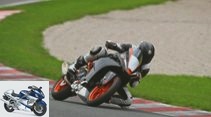
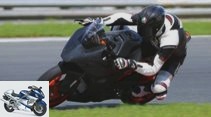
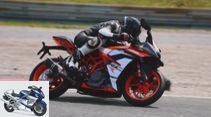
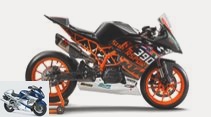
13 photos
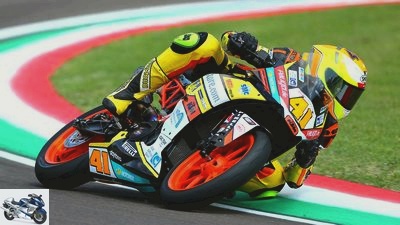
KTM
1/13
Supersport 300 doesn’t exactly sound like a big battle for racers spoiled by 1000s. But for youngsters it is finally an affordable opportunity on the way to the world’s elite. Because power alone doesn’t make world champions!
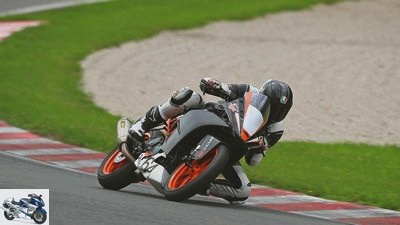
KTM
2/13
The RC 390 R is also used in the ADAC Junior Cup. In addition to the other cladding, only an additional Akrapovic steel exhaust is used here.
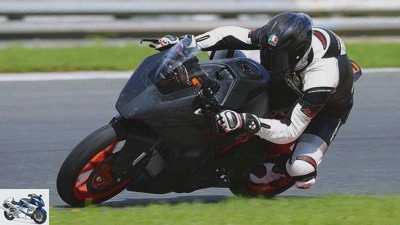
KTM
3/13
Full kit program with a full performance plus for the SSP 300 racer that feels like a real racing motorcycle.
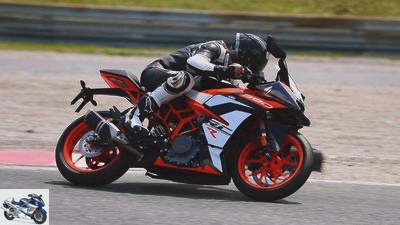
KTM
4/13
One of 500 KTM RC 390 Rs – a lot of athletes, but for beginners on the road.
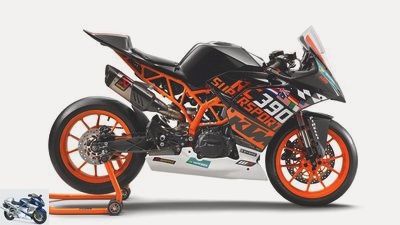
KTM
5/13
The KTM RC 390 R in the SSP 300 version.
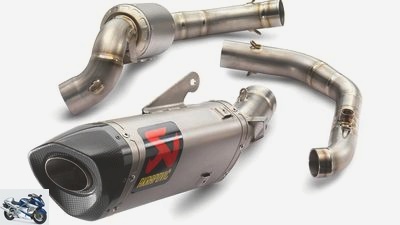
KTM
6/13
A complete titanium system from Akrapovic is included in the kit for extra performance.
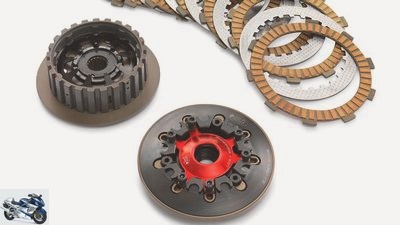
KTM
7/13
The slip clutch from the kit enables the motorcycle to “slide” into the curve with a lot of speed and control. It comes from the coupling specialist STM.
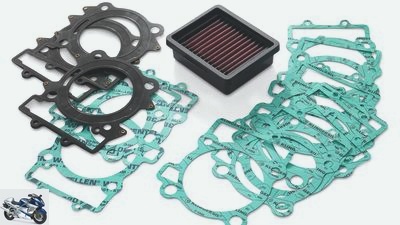
KTM
8/13
In addition to the racing air filter and numerous service seals for all aspects of the engine, the kit also includes a special head gasket with which the compression of the single cylinder can be increased to 12.9: 1.
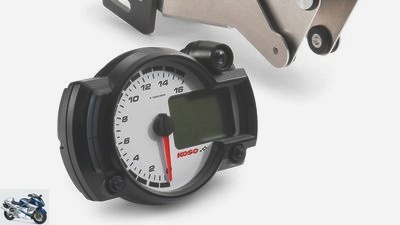
KTM
9/13
The instrument holder not only saves weight, but also holds the race dashboard and the ECU.
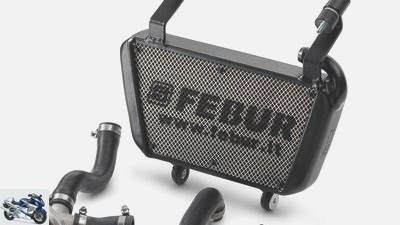
KTM
10/13
The cooler kit comes from Febur, which in addition to the radiator also offers all the necessary connecting hoses, clamps and connectors.
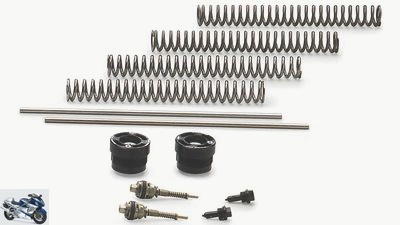
KTM
11/13
The same applies to the shock absorber, which is already part of the R series. However, the spring rate can be varied and can be adapted to the driver and the respective route using kit shims.
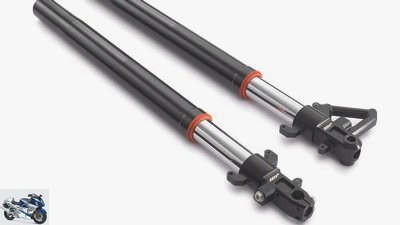
KTM
12/13
The fork itself is not part of the kit. It is already installed in the series RC 390 R and, thanks to the race kit, gets new fork springs, shims and a rebound and compression stage setting so that the motorcycle can be individually tailored to each route.
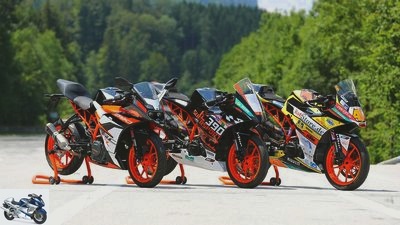
KTM
13/13
For homologation to the SSP 300 class, in addition to the “normal” RC 390 for beginners, KTM has built 500 RC 390 Rs (left in the picture), which still have to be street legal, but have a better chassis, the short intake funnel and the racing – owns fork bridge. The result is the kit bike (center) and Jan-Ole Jahnig’s world championship racer.
KTM RC 390 R Serie / Cup / SSP 300 in the test (2018)
Racing material for the youngsters
Content of
Supersport 300 doesn’t exactly sound like a big battle for racers spoiled by 1000s. But for youngsters it is finally an affordable opportunity on the way to the world’s elite. Because power alone doesn’t make world champions! We took a closer look at the KTM RC 390 R, in the series version, as a cup model and as an SSP-300 bike.
M.oto3, even on a national level in Spain, which is so important for motorcycling, is damn expensive. “200,000 euros are usually not enough as a dowry from the driver to upgrade to really competitive equipment,” says Dario Giuseppetti. The ex-125cc GP driver and super-fast former IDM superbiker should know. He has passed through many different classes during his playing career and has worked for several Moto3 and Moto2 teams in Spain since retiring. He also looks after the German offspring for the ADAC – for example in the Junior Cup. In addition to the high costs for Moto3, the breakdown of the 600 series in many countries and the greatly reduced interest in the supersport class in general made it very difficult for the youngsters to even find the right entry. Not to mention committed sponsors in this country despite the flourishing economy.
Supersport 300 class also in the IDM
Fortunately, something has happened with the Supersport 300 class, which has also been driven in the IDM since last season. On the one hand, the exact same rules are used in the USA, Australia, Spain or Germany, which allows a certain degree of comparability among all the talents. On the other hand, there is the class with the same regulations as part of the Superbike World Championship on the international stage. Kawasaki Ninja 400, Yamaha-R3 and KTM RC 390 R are used for driving. With changes in engine speed and total weight, the differences between one-cylinder and two-cylinder, displacement and power are adjusted and the costs are capped with finished racing kits.
The KTM RC 390 R in three expansion stages
PS was able to test the KTM RC 390 R in three expansion stages exclusively at the Salzburgring and talk to the head of the KTM customer racing department, Wolfgang Felber. The experienced technician, who also built the RC8 and is currently developing a dirt tracker for the US championship, had a clear goal when designing the Supersport 300 kit. “We wanted to be able to offer a motorcycle with a complete kit from the fairing to the second set of wheels for rain races, which can race for victories immediately after the conversion – without additional tuning and the extreme know-how of highly specialized racing technicians,” he explains. With 11,000 euros on top of the kit for the homologation bike RC 390 R (for 8,500 euros) comprising a total of 230 parts, you can claim to be able to win Supersport 300 races everywhere, at least in terms of material – including in the World Cup.
KTM
The 390 KTM is also used in the ADAC Junior Cup.
And this race kit has it all. It pushes the total weight of the standard KTM RC 390 R in racing trim to 131 kilos. Light cladding, corresponding wiring harness, slimmed-down cockpit, bearings, screws, brackets – all of this saves almost 16 kilos compared to the street model with mirrors, lighting system, etc. This means that the racing version is now so light that the KTM youngsters have to drive around with up to eleven kilograms of additional weights after the introduction of a minimum weight of 208 kilos for the machine plus driver.
However, we are spared this problem (we bring our extra weight with us), which is why the SSP 300-KTM is easy to steer like a bicycle and thanks to the kit chassis optimization that KTM developed with chassis specialist Andi Vogt, with crisp feedback and downright stapled to a close line fascinated. Despite the few bends at the Salzburgring, the two alternating bends before start / finish and the chicane afterwards make it clear how hard the ultra-light KTM with the stiff chassis, which has only slightly changed geometry and the stiff dampers compared to the series, folds down. Compared to an extremely handy 1000, it’s like from another planet. Completely new chassis parts such as fork or shock absorber are not required at all, because according to the regulations of the KTM RC 390 R, only the spring and shims can be installed at the rear and the fully adjustable fork kit at the front for the SSP 300. You can then work and learn professionally on the chassis.
In comparison RC 390 R and SSP 300
A direct comparison with the KTM RC 390 R shows how big the difference is. Although this is already equipped with the homologation fork and the WP shock absorber and also has a more professional fork bridge and stub compared to the simple RC 390, the leap is to SSP 300 version huge. Everything is exponentially more “tangible”. Once mounted, the SSP 300 instantly looks like a real racing motorcycle. Thanks to the complete fairing with a stiff hump and thin seat bun, the direct connection to the rear wheel is right. Vogt’s coordination work takes care of the rest. “The KTM offers a lot of possibilities,” explains Jan-Ole Jahnig. The 17-year-old student from Altenburg rides for the Freudenberg team on a KTM in the SSP 300 World Championship and won the class in the IDM last season on a Yamaha R3. “The tubular space frame alone makes the KTM much stiffer, the Yamaha was much softer overall. As a result, the setup was not that crucial. At KTM, I have to work a lot more on it. But if it fits, the RC is a perfect racing motorcycle, ”said the top ten driver, who has the world title firmly in view for the next season.
KTM
With a racing kit, the 390 becomes a real racing bike.
Jan-Ole’s enthusiasm for his current set also stems from the performance of the Kit-390s. Again compared to a 1000, it is poor. But with 52 HP, the kit racer is actually pretty much in the juice. That is why the regulations had to be adjusted after two races and the original maximum speed of the SSP 300-KTM had to be reduced from 11,000 / min to just 10,450 / min – the KTM was above all to be considered over the Yamahas, which are now allowed to use other camshafts. But how does the extra power of nine hp for a production bike come about despite tight regulations? “We are allowed to use a complete titanium system from Akrapovic to increase performance and only increase the compression on the engine itself, which is why the race kit only contains a corresponding head gasket,” explains Felber. The kit motor now compresses with 12.9: 1 (series: 12.5: 1). In addition, KTM has already given the 500 KTM RC 390 R copies required for homologation a shorter intake funnel – if you leave out the corresponding kit ECU with the corresponding “race mapping”, it was with performance-enhancing measures.
“It’s not just about preventing the increase in performance through rampant and therefore expensive tuning for reasons of cost,” Felber explains the considerations. “The engine is sealed and can only be overhauled twice in total during the season. So it has to last – that also saves a lot of money. ”The fact that such a small motor has to withstand the corresponding thermal loads requires the more effective kit cooler. In order to really fire the SSP 300 into corners – and that means taking a lot of momentum with a manageable performance – the kit also includes a slipper clutch that neatly irons away the surprisingly significant braking torque of the R-Basis. After the acceleration phase out of the chicane at the end of the start / finish up to sixth gear, braking very late into the Nockstein turn while simultaneously downshifting into third or fourth gear. Thanks to the kit coupling, the SSP 300 pilot can then quickly release the lever and storm towards the apex of the curve with a lot of momentum.
KTM
The standard version is also a solid athlete for beginners.
Jan-Ole Jahnig also showed how fast the guys are with the near-series, around 50 hp motorcycles. In Assen, he finished eighth with a fastest lap time of 1.52.5 minutes. His team-mate and race winner Luca Grunwald, who already drove a Moto3 GP season in 2014, even put in a 1.51.9-minute race lap, the fastest driver drove just over 1.50 minutes. Really good lap times, which show that even smaller bikes as Supersport 600s, apart from the expensive small GP classes, can be an important part of a young racer’s career. From the Junior Cup KTM RC 390 R to the SSP 300, that already applies. And then Moto2 or the Supersport World Championship? In addition to a lot of luck and loyal sponsors, that must above all show the talent.
Related articles
-
Test of BMW racing bikes BMW IDM-S 1000 RR and BMW HP4 Race
BMW 12th photos BMW 1/12 BMW IDM-S 1000 RR and BMW HP4 Race in the test. BMW 2/12 BMW IDM-S 1000 RR. 171 kg, 200 hp. BMW 3/12 A must-have for racing…
-
Yamaha MT-07 model year 2017 and 2018 test
Arturo Rivas 16 pictures Arturo Rivas 1/16 The Yamaha MT-07 models from 2017 and 2018 in a comparison test. Arturo Rivas 2/16 2018: The damper …
-
48 hp motorcycles (model year 2019) in a comparison test
46 photos Jorg Kunstle 1/46 Six motorcycles compete against each other in the 48 hp comparison test. The models Kawasaki Z 400, KTM 390…
-
Stingl-Yamaha YZF-R6 in the test
Shiny 15th photos Shiny 1/15 The 600 burner from Yamaha is known for this: lively, easy-turning and agile, but nothing works below 10,000 rpm. But that’s…
-
triumph Track test: racing triumph Triumph as a racing version Whether in the Supersport World Championship or in cup races – the British three-cylinder…
-
Comparison test: Ducati 1198 SP and KTM RC8 R
fact 25th photos fact 1/25 Classically functional tubular space frame. fact 2/25 Throttle body. fact 3/25 It has to be fun: sunny Spain, hot tires and…
-
Presentation of the MV Agusta F4 RC – model year 2017
MV Agusta 11 pictures MV Agusta 1/11 MV Agusta F4 RC. MV Agusta 2/11 MV Agusta F4 RC. MV Agusta 3/11 MV Agusta F4 RC. MV Agusta 4/11 MV Agusta F4 RC. MV …
-
Comparative test of the super sporty 600 series, part 2
Gargolov comparison test super sporty 600, part 2 roundabout last groove and full of gas ?? when comparing the racetrack there is for the …
-
Comparison test Aprilia RS 250 against Honda NSR 250
Comparison test Aprilia RS 250 against Honda NSR 250 Sports mirror Aprilia versus Honda – Italy versus Japan. The tough Grand Prix duel of lightning-fast…
-
Race bike: Kainzinger-KTM RC8 R Track in the test
fact The race bike Kainzinger-KTM RC8 R Track in the race track test Race bike: Kainzinger-KTM RC8 R Track Content of Austrian bike, German tuner, Swiss…